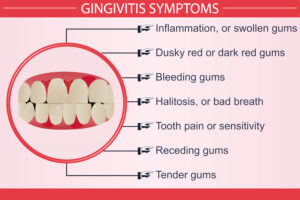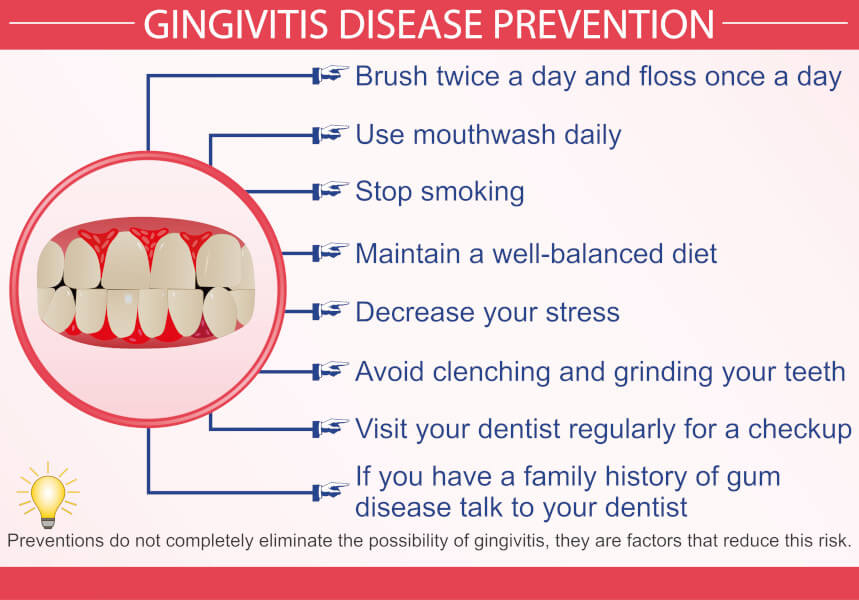Gingivitis is an early-stage form of gum disease that precedes the more advanced and serious form called periodontitis. Its onset occurs with the build-up of bacteria that can lead to infection and cause red, sore, and swollen gums.
The onset of gum disease lies with bacteria. While we all have and need bacteria in our mouths, there are some types that build to form plaque and infect when there is poor oral hygiene, and this is what causes gum disease.
During the early stages, the plaque hardens to turn to tartar and irritate the gum-line. This is called gingivitis. Left untreated, this relatively mile condition can quickly progress into a more serious condition called periodontitis.
Patients who have overcrowded and crooked teeth, diabetes, a family history of gum disease, and those going through hormonal changes such as puberty, menopause or pregnancy are at higher risk for gum disease. Use of tobacco (smoking or chewing) and certain medications can also increase the risk.

Gingivitis Symptoms
The majority of gingivitis symptoms will be centered around the gum line. Check regularly to see if you have red or swollen gums and for signs of gum recession (i.e. when the gum line recedes to expose part of your tooth root). Your gums may also bleed more easily, especially when brushing or flossing, and in some cases, they may be slightly sore or tender. You may also notice some bad breath.
Be aware, however, that early gum disease is often not associated with any pain or very noticeable symptoms, so it is important to pay careful attention and visit your dentist regularly for checkups in order to prevent progression into periodontitis!
Gum Disease Stages
The onset of periodontitis is preceded by a milder form of gum disease known as gingivitis. At this stage, a thorough and professional teeth cleaning is often enough to halt the progression into periodontal disease.
Gingivitis
As mentioned above, gingivitis is the earliest stage of gum disease. At this stage, the infection is fairly superficial and can often be treated easily through professional teeth cleaning by your dentist and regular at-home care. Sometimes, corrective treatments may be required if there are other dental issues that irritate the gums or make oral hygiene difficult.
The onset of periodontitis occurs when the gum recedes to form pockets that harbor more of the harmful bacteria. At this stage, the infection becomes harder to control and can easily continue its progression into the later stages of periodontitis. Symptoms at this stage include deterioration and damage not only to the gums but also to the bone, teeth, and connective tissue, leading to foul breath, severe pain, and even tooth loss.
Gingivitis Treatment and Prevention

Regular Dental Care and Hygiene
It is estimated that over half of adults over the age of 30 suffer from some form of gum disease. At its earliest stages, the best and most sustainable gingivitis treatment is to practice good, standard oral hygiene. This includes regular professional teeth cleanings by your dentist followed by brushing thoroughly and flossing twice daily. Professional teeth cleanings should continue on a regular basis, at least twice annually. If caught early enough, these practices should be enough to reverse gingivitis and prevent future onsets of the disease.
Prescription Medication
If standard oral hygiene practices are not effective enough in treating some persistent cases of gingivitis, a medicated mouth wash may be prescribed by your dentist. The purpose of the mouth wash is to help kill any stubborn bad bacteria that don’t resolve with professional teeth cleaning and your standard at-home oral hygiene practices. Like any medical prescription, you should continue this treatment for the full duration recommended by your dentist and accompanied with continued daily brushing and flossing for best results.
Scaling and Root Planing
A technique used also for early-stage periodontitis, scaling and root planing are deep cleaning procedures that can be performed by your dentist. Scaling involves scraping off the plaque and tartar from the gum line while root planing focuses on the tooth root, smoothing it out to remove any bacteria. This promotes reattachment of your gums back to the tooth to close any bacteria-forming pockets. As with all dental treatments, this procedure should be followed up by good oral hygiene practices to prevent the recurrence of the disease.